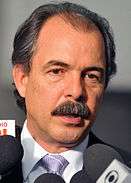2006 São Paulo gubernatorial election
The São Paulo state elections of 2006 was held along with Brazilian general elections, on October 1 and on October 29, 2006. Since 1994, as a result of a constitutional amendment which reduced the presidential term to four years, all federal and state elections in Brazil have coincided. The state elections decide Governors and the state deputies for the Legislative Assemblies. Also, the members of the National Congress are elected by state.
| ||||||||||||||||||||
| ||||||||||||||||||||
| ||||||||||||||||||||
Governor and Vice-Governor
In general, the rules of the presidential ballot also apply to the gubernatorial one. That is, the ballot is taken in two rounds, if no one reaches at least an absolute majority of the valid votes, a second round between the two most voted candidates will be held. All the candidates holding executive posts had to renounce till April 2, 2006 in order to be able to run.
The candidates for Governor of São Paulo were, in no particular order:
- The Brazilian Social Democracy Party (PSDB) – was the governing party, but governor Geraldo Alckmin could not run for reelection. Thus, the party had to appoint a new name for the run. After governor Alckmin was selected as the presidential candidate on a dispute with the state capital mayor José Serra, it was proposed that Serra should be the candidate for the state government.
- Workers' Party (PT) – the main opposition party in the state held primaries and chose Aloízio Mercadante, senator of São Paulo in the fourth year of his term (the term of a senator in Brazil is eight years-long).
- Brazilian Democratic Movement Party (PMDB) – chose former governor of São Paulo Orestes Quércia as their candidate.
- Other candidates included Plinio de Arruda Sampaio (PSOL) and Carlos Apolinário (PDT)
Results
| Party | Candidate | Votes | % | |
|---|---|---|---|---|
| Brazilian Social Democracy Party (PSDB) | José Serra | 12,381,038 | 57.93% | |
| Workers' Party (PT) | Aloízio Mercadante | 6,771,582 | 31.68% | |
| Brazilian Democratic Movement Party (PMDB) | Orestes Quércia | 977,695 | 4.57% | |
| Socialism and Liberty Party (PSOL) | Plínio Soares de Arruda Sampaio | 532,470 | 2.49% | |
| Democratic Labour Party (PDT) | Carlos Apolinário | 430,847 | 2.02% | |
| Green Party (PV) | Cláudio de Mauro | 186,097 | 0.87% | |
| Brazilian Socialist Party (PSB) | Mario Luiz Guide | 39,857 | 0.19% | |
| Social Christian Party (PSC) | Tarcisio Roberto Foglio | 17,420 | 0.08% | |
| Christian Social Democratic Party (PSDC) | Antonio da Cunha Lima | 7,073 | 0.03% | |
| Party of the Nation's Retirees (PAN) | Roberto Gandolfo Sarli Junior | 6,607 | 0.03% | |
| Christian Labour Party (PTC) | Eder Xavier | 6,047 | 0.03% | |
| Social Liberal Party (PSL) | Roberto Siqueira Gomes | 5,982 | 0.03% | |
| Workers Cause Party (PCO) | Anai Caproni Pinto | 5,902 | 0.03% | |
| National Labor Party (PTN) | Alfredo Martins Correa | 4,523 | 0.02% | |

